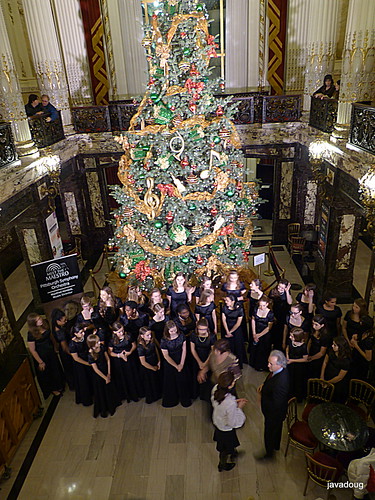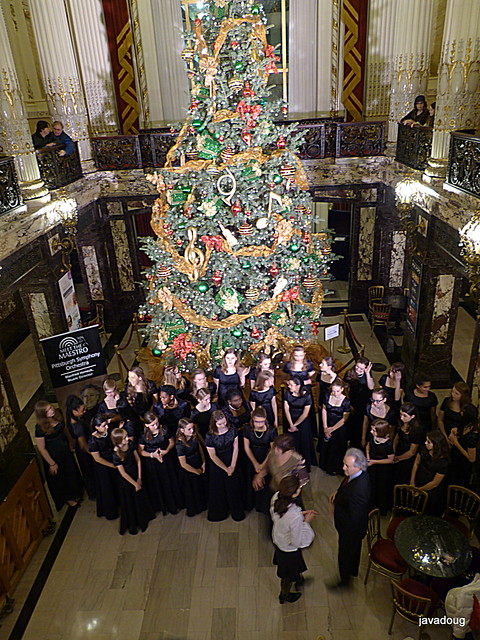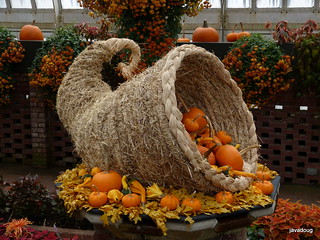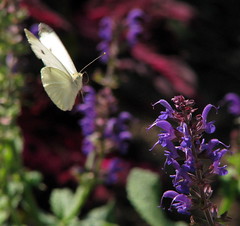
I took my daughter to the PSO concert Saturday night. She stayed to listen to the pre-concert talk by Fawzi Haimor, Assistant Conductor of the Pittsburgh Symphony Orchestra while I went out to listen to the choir in the lobby and take photos. She reported that Mr Haimor played several selections which were due to be performed during the forthcoming concert. He was casual and funny in his descriptions. You could hear the singing behind him. He looked around -- "I can hear the voices already;" there was laughter. Some of the Bruckner selections he played were quite loud. Paraphrasing one comment he made: "now that just screams superman, but don't go thinking about that while they're playing, just focus on the music." Later, my daughter reported that she "completely forgot about the superman reference during the concert."
Manfred Honeck came out onto the stage as the concert was about to commence. He indicated that he doesn't usually appear alone on the stage, in this case he was alone because the PSO would not accompany the Tallis Scholars and would only appear in the second half after intermission. Maestro Honeck described the placement of The Tallis Scholars in the same program as the Bruckner Symphony 4, they seemed to complement each other in a very interesting way. To me, the placement of these two very, different and very uniquely individual types of compositions seemed a very idiosyncratic juxtaposition, yet I was quite pleased with the result. Note that Bruckner himself had a wide range of types of music. One of his vocal compositions appears in the first half and his symphony in the second half. Here are some of the words Honeck used to describe the music: "unique and very special, architecturally a cathedral of sound, epoch and heroic with purity, pertaining to a special time and place, and that we should prepare our heart and mind for this very special sacred music."
"Not your average church youth choir!" -- a comment from my daughter during the performance.
I read in the program notes that he Tallis Scholars, considered one of the world's leading Renaissance vocal music ensembles, celebrate their 40th anniversary this year. During the first half of the concert, the Tallis Scholars presented an 'a cappella' program, including Allegri's famous Miserere, that highlight the Renaissance inspirations in the music of Bruckner.
The 'Miserere' was indeed the highlight of the night. The vocals were amazing. Five of the singers were on stage, and the other 5 were arrayed across the balcony tier. At first I didn't realize this, and since I was observing with binoculars, I was curious how they were making such beautiful voices without moving their lips. When I finally looked around I saw them down below on the tier. My daughter and I were both completely amazed at the purity of the vocals. After they were done the entire audience gave a standing ovation. Since I was all the way up on the back of the tier, literally the furthest away one could be, to me this was a first. Up there not everyone stands for an ovation, but this time they did. Also amazing were the acoustics at Heinz Hall, their voices resonated profoundly and with plenty of volume even up there.
Bruckner's Symphony No. 4 is subtitled "Romantic." The so-called 'programmatic' theme of the music had references to a medieval castle, knights on horseback, the beauty of Nature and a hunt. All of these aspects, if I think about it, do seem evident in the music, yet when I listened I focused on the music itself.
This is the second time I've heard this symphony with the PSO. The last was the beginning of February, 2009. I'm including my words from then because they apply to this second hearing very well, and fully describe my thoughts for both. The only difference is that this time I found the 1st and 4th movements to also be exceedingly well done by the PSO. Having heard this symphony now twice, it becomes one of my favorites.
The second movement of the Bruckner was my favorite. You hear the raw power of the Pittsburgh Symphony Orchestra strings, each member acting in unison, pushing the romantic uplifting theme, reverberating deep into my body and soul. In person it is worlds apart from a recording. The violas get to shine. As they play with alacrity and potency, their theme is counter-posed by the rest of the strings preforming pizzicato. Interesting how only 12 viola players can put forth so much volume, when compared to perhaps 26 violins and the rest of the strings, not to mention the obvious fact that violas are facing away from the audience, yet it sounded wonderful, even to my ears, being seated in the very last row of the gallery, a testament to the acoustics at Heinz Hall.


















 The 2008-2009 Season marks the arrivals of Music Director Manfred Honeck and Principal Guest Conductor Leonard Slatkin, the return of some of the most talented guest conductors and soloists in the world, and concerts by the world-class musicians of the Pittsburgh Symphony Orchestra!
The 2008-2009 Season marks the arrivals of Music Director Manfred Honeck and Principal Guest Conductor Leonard Slatkin, the return of some of the most talented guest conductors and soloists in the world, and concerts by the world-class musicians of the Pittsburgh Symphony Orchestra!
